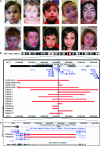The 2q23.1 microdeletion syndrome: clinical and behavioural phenotype
- PMID: 19809484
- PMCID: PMC2987180
- DOI: 10.1038/ejhg.2009.152
The 2q23.1 microdeletion syndrome: clinical and behavioural phenotype
Erratum in
- Eur J Hum Genet. 2010 Feb;18(2):170. Moloney, Susan [added]
- Eur J Hum Genet. 2010 Oct;18(10):1171
Abstract
Six submicroscopic deletions comprising chromosome band 2q23.1 in patients with severe mental retardation (MR), short stature, microcephaly and epilepsy have been reported, suggesting that haploinsufficiency of one or more genes in the 2q23.1 region might be responsible for the common phenotypic features in these patients. In this study, we report the molecular and clinical characterisation of nine new 2q23.1 deletion patients and a clinical update on two previously reported patients. All patients were mentally retarded with pronounced speech delay and additional abnormalities including short stature, seizures, microcephaly and coarse facies. The majority of cases presented with stereotypic repetitive behaviour, a disturbed sleep pattern and a broad-based gait. These features led to the initial clinical impression of Angelman, Rett or Smith-Magenis syndromes in several patients. The overlapping 2q23.1 deletion region in all 15 patients comprises only one gene, namely, MBD5. Interestingly, MBD5 is a member of the methyl CpG-binding domain protein family, which also comprises MECP2, mutated in Rett's syndrome. Another gene in the 2q23.1 region, EPC2, was deleted in 12 patients who had a broader phenotype than those with a deletion of MBD5 only. EPC2 is a member of the polycomb protein family, involved in heterochromatin formation and might be involved in causing MR. Patients with a 2q23.1 microdeletion present with a variable phenotype and the diagnosis should be considered in mentally retarded children with coarse facies, seizures, disturbed sleeping patterns and additional specific behavioural problems.
Figures

Similar articles
-
Haploinsufficiency of MBD5 associated with a syndrome involving microcephaly, intellectual disabilities, severe speech impairment, and seizures.Eur J Hum Genet. 2010 Apr;18(4):436-41. doi: 10.1038/ejhg.2009.199. Epub 2009 Nov 11. Eur J Hum Genet. 2010. PMID: 19904302 Free PMC article.
-
Phenotypic and molecular convergence of 2q23.1 deletion syndrome with other neurodevelopmental syndromes associated with autism spectrum disorder.Int J Mol Sci. 2015 Apr 7;16(4):7627-43. doi: 10.3390/ijms16047627. Int J Mol Sci. 2015. PMID: 25853262 Free PMC article.
-
Reciprocal deletion and duplication at 2q23.1 indicates a role for MBD5 in autism spectrum disorder.Eur J Hum Genet. 2014 Jan;22(1):57-63. doi: 10.1038/ejhg.2013.67. Epub 2013 May 1. Eur J Hum Genet. 2014. PMID: 23632792 Free PMC article.
-
Neurodevelopmental features in 2q23.1 microdeletion syndrome: report of a new patient with intractable seizures and review of literature.Am J Med Genet A. 2012 Apr;158A(4):861-8. doi: 10.1002/ajmg.a.35235. Epub 2012 Mar 9. Am J Med Genet A. 2012. PMID: 22407754 Review.
-
If not Angelman, what is it? A review of Angelman-like syndromes.Am J Med Genet A. 2014 Apr;164A(4):975-92. doi: 10.1002/ajmg.a.36416. Am J Med Genet A. 2014. PMID: 24779060 Review.
Cited by
-
Trapping MBD5 to understand 2q23.1 microdeletion syndrome.EMBO Mol Med. 2014 Aug;6(8):993-4. doi: 10.15252/emmm.201404324. EMBO Mol Med. 2014. PMID: 25001217 Free PMC article.
-
Molecular and Clinical Aspects of Angelman Syndrome.Mol Syndromol. 2012 Apr;2(3-5):100-112. doi: 10.1159/000328837. Epub 2011 Jul 28. Mol Syndromol. 2012. PMID: 22670133 Free PMC article.
-
RINGs, DUBs and Abnormal Brain Growth-Histone H2A Ubiquitination in Brain Development and Disease.Epigenomes. 2022 Dec 2;6(4):42. doi: 10.3390/epigenomes6040042. Epigenomes. 2022. PMID: 36547251 Free PMC article. Review.
-
A novel MBD5 mutation in an intellectually disabled adult female patient with epilepsy: Suggestive of early onset dementia?Mol Genet Genomic Med. 2019 Aug;7(8):e849. doi: 10.1002/mgg3.849. Epub 2019 Jul 9. Mol Genet Genomic Med. 2019. PMID: 31290275 Free PMC article.
-
MBD5 haploinsufficiency is associated with sleep disturbance and disrupts circadian pathways common to Smith-Magenis and fragile X syndromes.Eur J Hum Genet. 2015 Jun;23(6):781-9. doi: 10.1038/ejhg.2014.200. Epub 2014 Oct 1. Eur J Hum Genet. 2015. PMID: 25271084 Free PMC article.
References
Publication types
MeSH terms
Grants and funding
LinkOut - more resources
Full Text Sources

